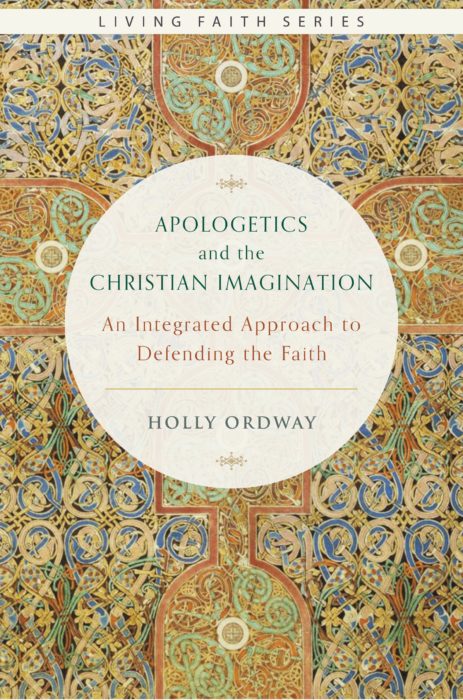‘Apologetics and the Christian Imagination’ Explores Why God Gives Us Stories
Theology and fiction have a notoriously uneasy relationship. In fact, some would even say they shouldn’t have one at all. For example, I recently encountered a homeschool group that was debating whether or not to let their kids read fiction. One mother summed up her refusal with what is the common objection:
“Fiction – by nature – is simply not true. God says to stay away from anything that is not true, so we do.”
Even though this response is relatively fringe, it nevertheless encapsulates the tenuous relationship between Truth-telling and Story-telling in the minds of many well-meaning believers.
The subtitle of Professor Holly Ordway’s new book, “Apologetics and the Christian Imagination,” is “An Integrated Approach to Defending the Faith.” Part of the “integration” Ordway is seeking to achieve is between similarly (potential) disparate elements, in this case Reason and Imagination.
Reason and Imagination are twin faculties, both part of human nature–and both given to us by God our Creator!–that, together, allow for a further grasp of the truth. (pp. 10-11)
Though “given to us by God,” imagination has typically been viewed with suspicion by evangelicals (a development which uniquely applies to fans of speculative genres). Rooted in the word “image,” evangelicals often associate the term with idolatry, as in “graven image” (which is one reason Protestants eschew icons and sacramentalism). Compound this with verses like Gen. 6:5, “…everything they thought or imagined was consistently and totally evil” (NLT) and II Cor. 10:5 “Casting down imaginations, and every high thing that exalteth itself against the knowledge of God…” (KJV), and a case could be made that imagination should indeed be suspect.
 On the contrary, Ordway suggests that cultivating and engaging the imagination is critical to our apologetics and our “grasp of the truth.” Part of this requires returning to a more classical understanding of the imagination. She writes,
On the contrary, Ordway suggests that cultivating and engaging the imagination is critical to our apologetics and our “grasp of the truth.” Part of this requires returning to a more classical understanding of the imagination. She writes,
For Aristotle, and for St. Augustine, St. Thomas Aquinas, St. Bonaventure, and other medieval scholars and theologians, the imagination has a cognitive function: it mediates ‘between sense and intellect’ by conveying ‘data to the intellect’ . . . Imagination is the human faculty that assimilates sensory data into images, upon which the intellect can then act; it is the basis of all reasoned thought as well as all artistic, or what we would call ‘imaginative,’ exercise. (p. 16)
So in the classical sense, imagination is more than just daydreaming and conjuring up fanciful places and characters. Rather, the imagination provides the raw material upon which the intellect can then operate. Images create the stuff upon which Reason can engage.
For the Christian fiction fan (and Christian fiction writer), cultivating this God-given faculty means more than just permitting ourselves to be wildly creative. It involves recognizing that fiction can impact our “sense and intellect,” and that we engage fiction differently than we engage a sermon or propositional arguments.
By way of example, Ordway uses C.S. Lewis (and herself) to describe what she calls “a two-step conversion” (p. 10). The first step in Lewis’ conversion was “a conversion to Theism, not to Christianity” (p. 7). He moved from strict atheism to a belief in God. It was an inability to grasp certain doctrinal issues, namely the Atonement, that prevented Lewis from taking the next step and embracing Christianity. This changed when Lewis’ Imagination was engaged. Specifically his love for myth and how Christ was “the true Myth” or “Myth become flesh.” Ordway summarizes,
When Lewis realized that he could connect his imaginative response to the story, to the factual reality of the Christian claim about the Crucifixion and Resurrection, the final barrier to belief fell. He could become a Christian as a whole person, with both his imagination and his reason fully engaged. (p. 8)
In a similar way, Ordway testifies to how, even as an atheist, Tolkien’s “Lord of the Rings” and Lewis’ “Chronicles of Narnia” so powerfully prepped her for the Gospel.
… although I was not interested in Christianity, I had, without knowing it, been experiencing the work of grace through my imagination. As a child and young adult, I read fantasy, fairy tales, and myths, and especially fell in love with the Chronicles of Narnia and the Lord of the Rings. I didn’t know that I was encountering God’s grace through those books, but in fact I was. (p. 9)
That a work of fantasy fiction could have such a profoundly redemptive influence on a reader may come as a surprise to some. However, it is just such a realization that often motivates the hopeful Christian creative. Because of this, Ordway sees art and fiction as part of a larger, integrative approach to apologetics. While preaching and propositional reasoning are integral elements of presenting the Gospel, they are just part of “a spectrum of engagement” (p. 31) — engagement aimed at “three transcendentals,” namely, goodness, truth, and beauty.
Ultimately, the coherence and soundness of Christian teaching (truth), the witness of the Faith lived out faithfully in individual lives, families, and communities (goodness), and the experience of the aesthetic, emotional, and spiritual riches of the liturgy and the arts (beauty) are all connected. Our faith is deeply rooted and fully nourished only if we have all three transcendentals in our lives: goodness, truth, and beauty. Likewise, our apologetics and our evangelization will be most attractive, compelling, and convincing if we draw on all three. Truth, for the intellect; goodness, for the moral sense and the will; beauty, for the aesthetic sense, the emotions, and the imagination. In this way, our apologetics can touch mind, heart, and will, not in isolation, but in harmony with each other. (pp. 167-168)
None of this is to suggest that straightforward declaration and defense of the Gospel are inadequate. Ordway is clear to assert the need for teaching about doctrine. Her turn is to broaden our understanding of this “spectrum of engagement,” one that includes both Reason and Imagination. In such an approach, architecture, art, music and literature can all be tools in the evangelist’s hands.
Literature and the arts have much to offer us in our apologetics work. It is not the same thing as making an argument on the form of a story; rather, at its best, it shows the truth and helps us desire it. It is not a substitute for teaching about doctrine, but it helps us see what doctrine means, and suggests that we might want to discover whether it is really true. (p. 146, emphasis in original)
In this way, effectively communicating the Gospel involves a balance of both narrative and propositional arguments. The Bible itself is an interesting balance of both. Jesus, for example, told evocative, imaginative stories. But he also preached the Sermon on the Mount. We can go to the Bible for numerous rich, compelling stories. But we can also go to it for explicit commands and principles. It has narrative and propositional power. Likewise, Christian storytelling should not be seen as an end in itself. It serves a specific function — one that moral argument cannot necessarily accomplish — but is incomplete without a balance of propositional arguments.
In the past, I have lamented about the need for a more theologically rigorous approach to Christian speculative fiction. Evangelical readers were often too busy debating about whether witches, spells, or zombies were appropriate fictive archetypes to dig into a broader, more substantive theological vision. Thankfully, Holly Ordway has done a great service to Christian creatives by providing us with such a theological undergirding for our imaginative efforts. “Apologetics and the Christian Imagination” is a valuable tool for the Christian speculative fan and a great reminder how a good story can do much more than just provide mindless entertainment; it can evoke beauty, prick our consciences, and point us toward Home.





































I’m convinced that spiritual truth can only be conveyed to us through metaphor. It’s how we see the unseen. Fiction can be a wonderful metaphor. That’s why I write it.
I would just say that their kids are gonna resent them if they can’t be arsed to distinguish between what’s actually harmful and what only needs to be taken with a grain of salt. Ask me how I know.